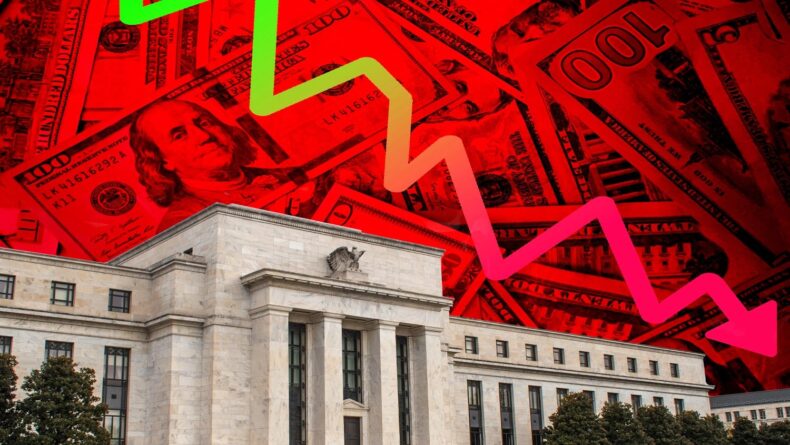The economic slowdown has caused anxiety among people, especially those who are struggling to support themselves due to rising prices and limited job opportunities. Businesses are also suffering, leading to job losses and reduced economic activity. Policymakers and economists are monitoring the situation and working on solutions to prevent further damage to the global economy.
All eyes are fixated on America as the global economy grapples with a multitude of issues. The current scenario has been worsened by the rise in inflation, the Ukraine-Russia war, and the COVID-19 pandemic. Recently, two banking failures in the US have further raised concerns about the stability of the financial system. The recent banking failures happened when there was a significant increase in borrowing costs around the world. This sudden shock has made the global economy unstable, and people are worried that there might be a severe economic slowdown known as a recession.

To counteract the negative impact of the COVID-19 pandemic and the Ukraine-Russia war, the Federal Reserve (Fed) has raised interest rates to their highest level in four decades. This move has caused borrowing costs to increase and led to significant investment being redirected from the business world to the bond market. However, due to recent banking instability, many investors believe that the Fed will be cautious about making significant changes that could disrupt financial markets.
The Fed is expected to increase its fed funds target rate range to 4.75% to 5% on Wednesday, although some economists suggest that the central bank may pause its rate hikes due to concerns about the banking system. As of Tuesday, futures markets predicted an 80% likelihood of a rate increase. However, the Fed must balance its interest rate tools while also calming markets and preventing further bank runs. The concern is that higher rates could place additional stress on banking institutions and further restrict lending, which could harm small businesses and other borrowers.
The economic slowdown has caused anxiety among people, especially those who are struggling to support themselves due to rising prices and limited job opportunities. Businesses are also suffering, leading to job losses and reduced economic activity. Policymakers and economists are monitoring the situation and working on solutions to prevent further damage to the global economy.

All eyes are fixated on America as the global economy grapples with a multitude of issues. The current scenario has been worsened by the rise in inflation, the Ukraine-Russia war, and the COVID-19 pandemic. Recently, two banking failures in the US have further raised concerns about the stability of the financial system. The recent banking failures happened when there was a significant increase in borrowing costs around the world. This sudden shock has made the global economy unstable, and people are worried that there might be a severe economic slowdown known as a recession.
To counteract the negative impact of the COVID-19 pandemic and the Ukraine-Russia war, the Federal Reserve (Fed) has raised interest rates to their highest level in four decades. This move has caused borrowing costs to increase and led to significant investment being redirected from the business world to the bond market. However, due to recent banking instability, many investors believe that the Fed will be cautious about making significant changes that could disrupt financial markets.

The Fed is expected to increase its fed funds target rate range to 4.75% to 5% on Wednesday, although some economists suggest that the central bank may pause its rate hikes due to concerns about the banking system. As of Tuesday, futures markets predicted an 80% likelihood of a rate increase. However, the Fed must balance its interest rate tools while also calming markets and preventing further bank runs. The concern is that higher rates could place additional stress on banking institutions and further restrict lending, which could harm small businesses and other borrowers.
The Global Impact of Rising Interest Rates in the United States
The United States Federal Reserve (Fed) plays a critical role in setting interest rates, which have a significant impact on the global economy. When the Fed increases interest rates, it affects the entire world in various ways, from currency exchange rates to investment and borrowing costs.
Currency Depreciation
The US dollar’s value typically rises when the Fed raises interest rates, as investors are attracted to higher returns in the US. This can result in a stronger dollar, making other currencies weaker and less valuable in comparison. This can impact the competitiveness of other countries’ exports, which can reduce their trade volumes and hurt their economies.

Borrowing
Rise in US interest rates makes it more expensive for businesses to borrow money, which can result in reduced investment and slower economic growth worldwide. This effect can be especially pronounced in developing countries that rely on borrowing to finance growth.
Consumer Spending
Higher interest rates can result in decreased consumer spending, as individuals may be more reluctant to take out loans or use credit cards due to the increased cost of borrowing. This can lead to lower sales for businesses and reduced economic activity.

Financial Instability
A rise in US interest rates can also increase global financial instability, especially in emerging markets, as investors may move their money from riskier investments to US Treasury bonds, which are perceived as safer. This can result in financial turbulence in countries that rely on foreign investment and lead to currency fluctuations, capital outflows, and economic downturns.
In conclusion, the Fed’s decision to raise interest rates can have far-reaching effects on the global economy, including currency exchange rates, borrowing costs, investment flows, and consumer spending. Policymakers worldwide must monitor and manage these impacts to maintain economic stability and promote sustainable growth.












